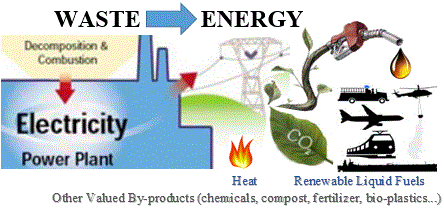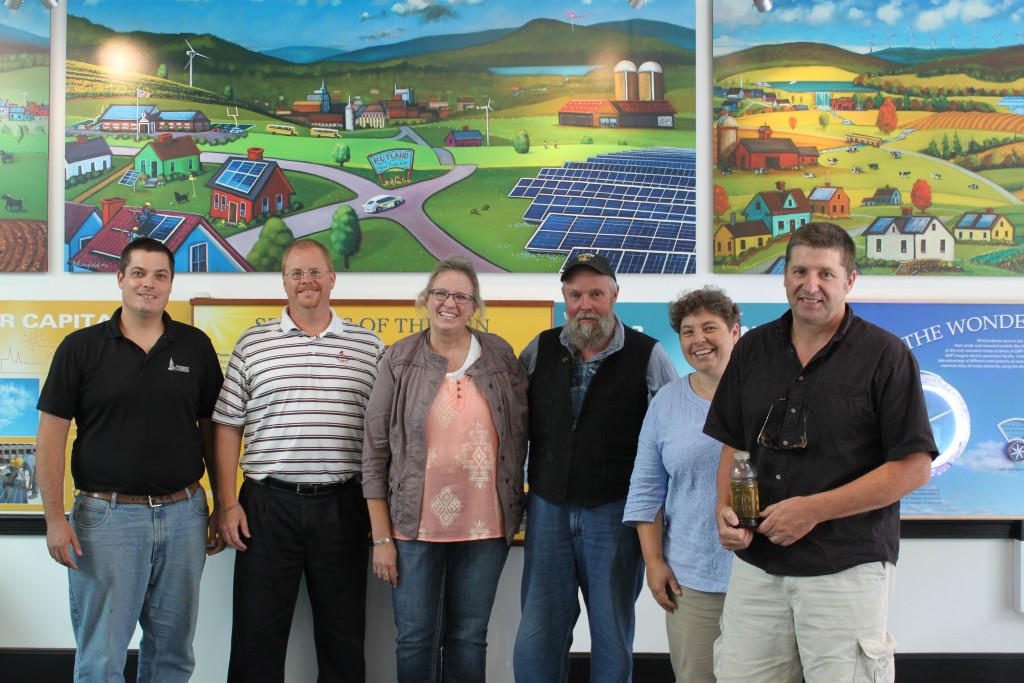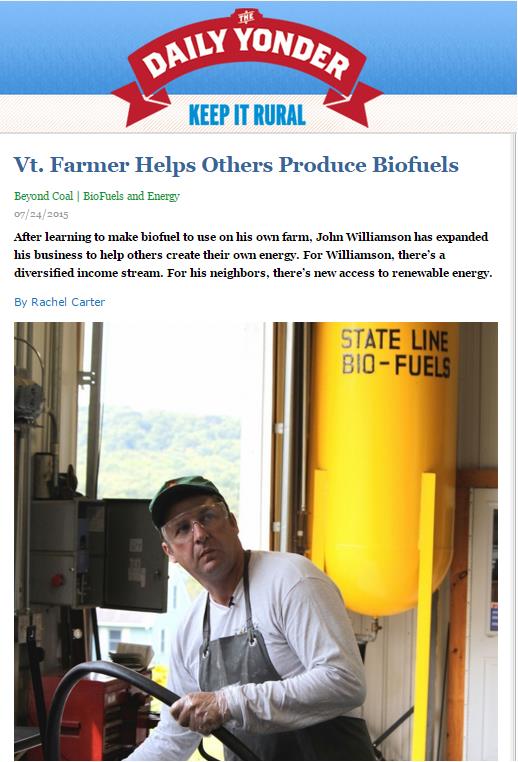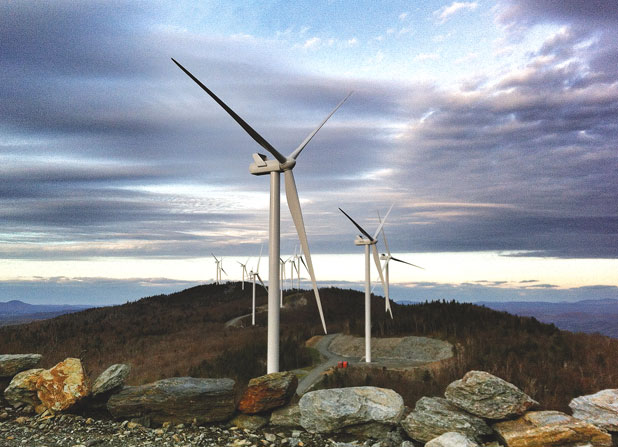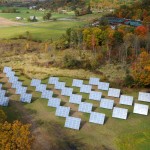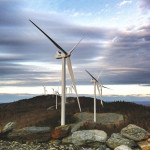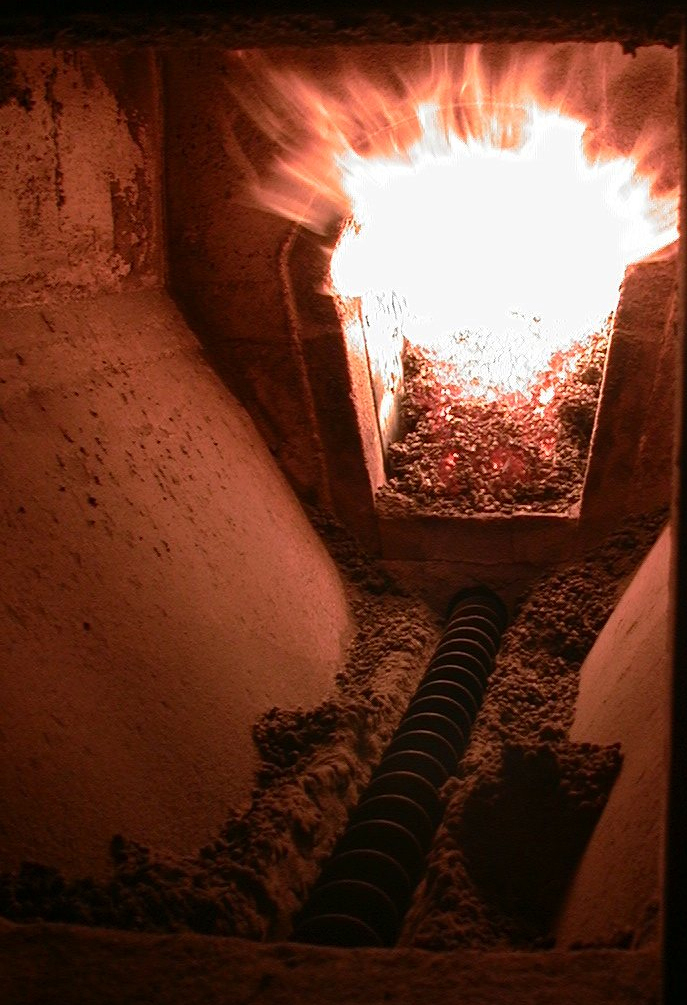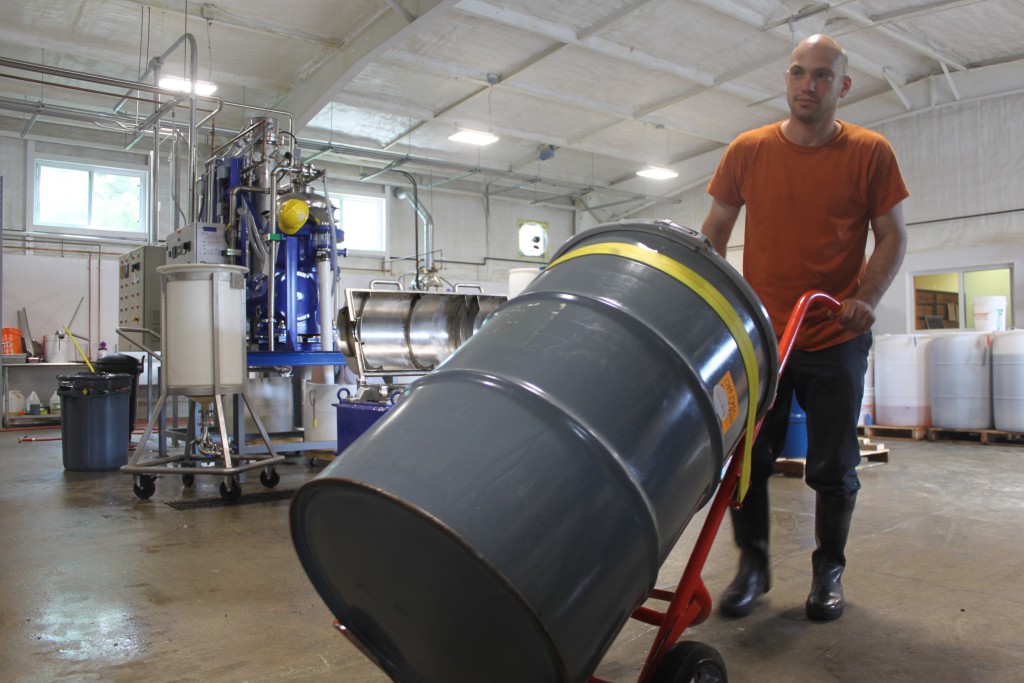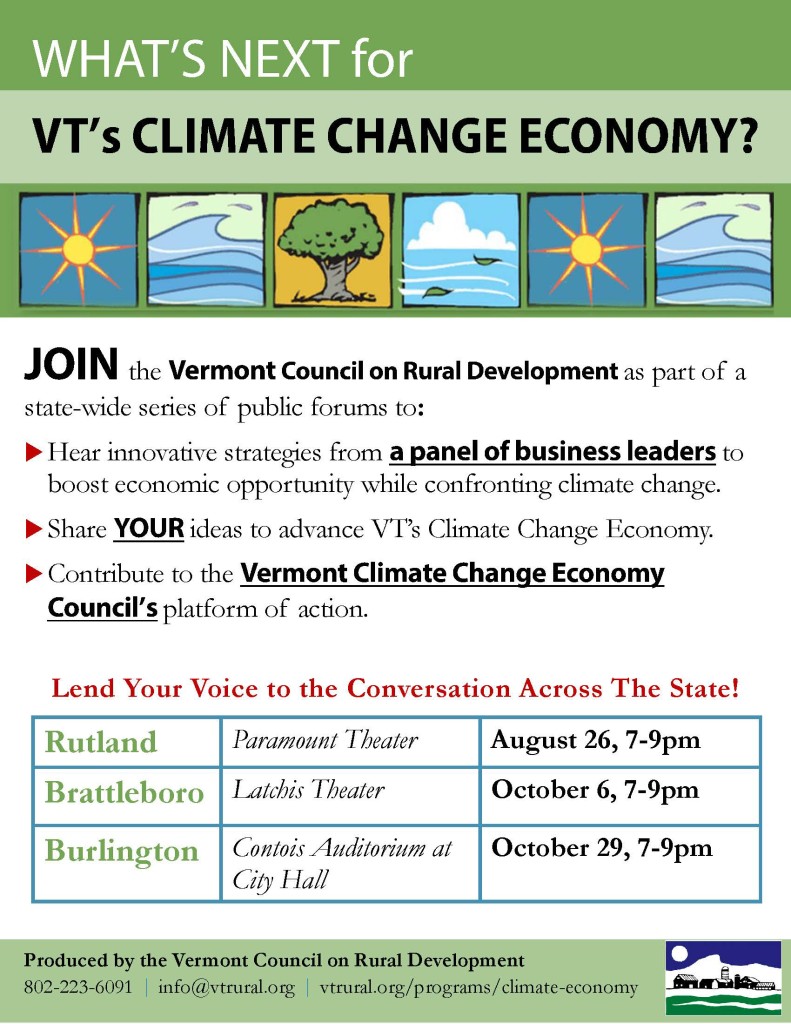![energy[1]](http://vermontbioenergy.com/wp-content/uploads/2015/12/energy1-300x141.gif) Following the Fall Semester UVM bioenergy course Bioenergy: Biomass to Biofuels, the University of Vermont will be offering a new bioenergy course this spring entitled Waste to Energy: Community Development Application. The course will again be taught by Anju Dahiya, cofounder of General Systems Research, LLC (GSR), lead biofuels instructor at the University of Vermont’s Rubenstein School of Environment and Natural Resources, and a Vermont Bioenergy Initiative algae for biofuel grant recipient. This course is open to both degree and non-degree students from any background or department, as well as farmers, entrepreneurs, and teachers interested in developing curriculum, or projects at school or college levels. This course is also approved for graduate credit.
Following the Fall Semester UVM bioenergy course Bioenergy: Biomass to Biofuels, the University of Vermont will be offering a new bioenergy course this spring entitled Waste to Energy: Community Development Application. The course will again be taught by Anju Dahiya, cofounder of General Systems Research, LLC (GSR), lead biofuels instructor at the University of Vermont’s Rubenstein School of Environment and Natural Resources, and a Vermont Bioenergy Initiative algae for biofuel grant recipient. This course is open to both degree and non-degree students from any background or department, as well as farmers, entrepreneurs, and teachers interested in developing curriculum, or projects at school or college levels. This course is also approved for graduate credit.
![food-waste[1]](http://vermontbioenergy.com/wp-content/uploads/2015/12/food-waste1-300x72.gif) In a Vermont post Act 148, the universal recycling law for solid waste, food waste, dairy farm manure, municipal wastes, landfill waste, carbon exhaust, nutrient runoff and other materials not being converted into value products are all resources that hold potential energy that can be developed in a sustainable way to power a local economy. This class focusing on waste sourced bioenergy comes on the heels of a promising results and continued work by Dahiya’s company GSR on incorporating algae into Green Mountain Power’s anaerobic digester at Nordic Farms in Shelburne, Vermont. The product serves as a strong example in which excess nitrogen and phosphorus in cow manure would find its way off farmland and end affecting health of natural water bodies, but instead is harnessed to make electricity and biofuel. As listed in the course catalog “the mission of this program is to provide hands-on instruction in all possible Bioenergy areas, support generation of related skilled workforce and stimulate sustainable energy production.”
In a Vermont post Act 148, the universal recycling law for solid waste, food waste, dairy farm manure, municipal wastes, landfill waste, carbon exhaust, nutrient runoff and other materials not being converted into value products are all resources that hold potential energy that can be developed in a sustainable way to power a local economy. This class focusing on waste sourced bioenergy comes on the heels of a promising results and continued work by Dahiya’s company GSR on incorporating algae into Green Mountain Power’s anaerobic digester at Nordic Farms in Shelburne, Vermont. The product serves as a strong example in which excess nitrogen and phosphorus in cow manure would find its way off farmland and end affecting health of natural water bodies, but instead is harnessed to make electricity and biofuel. As listed in the course catalog “the mission of this program is to provide hands-on instruction in all possible Bioenergy areas, support generation of related skilled workforce and stimulate sustainable energy production.”
![nutrients-pic-1[1]](http://vermontbioenergy.com/wp-content/uploads/2015/12/nutrients-pic-11-300x93.gif) Lectures will be held every on campus every Friday during the UVM spring semester from 12:00 pm to 3:00 pm, with 5 additionally required off campus field trips. The course required textbook, Bioenergy: Biomass to Biofuels, was edited by Anju Dahiya less than a year ago and represents a compilation of work from an extensive list of well-respected university extension programs, such as The University of Vermont Research Extension, as well as numerous national organizations including the US Department of Energy’s National Renewable Energy Laboratories.
Lectures will be held every on campus every Friday during the UVM spring semester from 12:00 pm to 3:00 pm, with 5 additionally required off campus field trips. The course required textbook, Bioenergy: Biomass to Biofuels, was edited by Anju Dahiya less than a year ago and represents a compilation of work from an extensive list of well-respected university extension programs, such as The University of Vermont Research Extension, as well as numerous national organizations including the US Department of Energy’s National Renewable Energy Laboratories.
Learn more about this course at the University of Vermont Renewable BioEnergy page or email the lead instructor Anju Dahiya at adahiya@uvm.edu.
02 Nov 2015
Vermont Bioenergy Initiative proves biofuel potential for state and concludes ten year project
By: Ellen Kahler
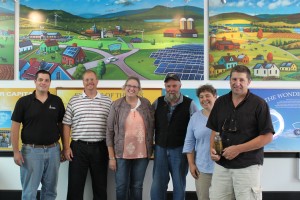
VT Bioenergy Team – L to R (Chris Callahan – UVM Extension, Kirk Shields — Green Mountain Power, Christy Sterner – US DOE, Larry Scott – Ekolott Farm, Ellen Kahler – VSJF, John Williamson – Stateline Biofuels) at Green Mountain Power’s Energy Innovation Center in Rutland
Vermont can produce more of its own biofuel energy and the environmental and potential economic benefits of local bioenergy have been proven by the Vermont Bioenergy Initiative – a program of the Vermont Sustainable Jobs Fund. Since 2005, the Vermont Bioenergy Initiative has invested more than $2.5 million in innovative bioenergy research, projects, and people so Vermont can locally produce more of the state’s energy needs – from a variety of agricultural and algal feedstocks.
US Senator Patrick Leahy made the investment at this scale possible through Congressionally Directed Awards from the US Department of Energy (US DOE). The funding concludes in early 2016, at which point a complete impact report will be released by the Vermont Sustainable Jobs Fund, who has served as the intermediary between the US DOE and 52 individual Vermont bioenergy projects over the past ten years.
Research, development, and early stage demonstration projects have included:
- Investing in 2 on-farm methane digesters;
- Building farm-scale infrastructure to turn oilseed crops such as sunflowers into biodiesel to run farm tractors;
- Growing switchgrass and densifying it into “pucks” that are burned in a high efficiency commercial boiler instead of propane;
- Identifying the most lipid producing strains of native Vermont algae which can feed off the excess nutrients from methane digesters and can eventually be harvested to make biodiesel or jet fuel;
- Developing two “Biomass to Biofuels” college level courses which run repeatedly at UVM and VT Tech to inspire and train the next generation of bioenergy experts and technicians;
- Exploring the logistics of bulk wood pellet delivery systems to Vermonters’ homes;
- Organizing a number of learning opportunities and conferences for oilseed, grass and algae researchers, farmers and entrepreneurs to attend;
- Providing agronomic and engineering support to oilseed and grass farmers;
- Educating the general public about why the local production for local use of energy crops from Vermont farms and forests makes good economic and ecological sense.
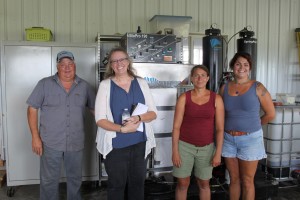
VT Bioenergy Team 2 – L to R (Roger Rainville – Borderview Farm, Christy Sterner – US DOE, Heather Darby – UVM Extension, Natasha Rainville – Borderview Farm) at Borderview Farm, Alburgh VT
The Vermont Bioenergy Initiative is a unique effort and one that is gaining resonance in other parts of rural America. The initiative’s resource website, www.VermontBioenergy.com is utilized by biofuel producers, educators, and technical service providers from across the country.
The work conducted over the past ten years by the Vermont Bioenergy Initiative to conduct research, provide technical assistance, and develop infrastructure in emerging areas of bioenergy will continue with the initiative’s partners at UVM Extension and the Vermont Agency of Agriculture, Food & Markets. As Vermont moves forward – being innovative and increasingly focused on generating renewable energy from the land and forests – the research and infrastructure the Vermont Bioenergy Initiative has invested in over the past ten years will endure and spawn the next wave of bioenergy development in the state.
Ellen Kahler is executive director of the Vermont Sustainable Jobs Fund (VSJF), a non-profit organization created by the State of Vermont to help develop Vermont’s sustainable agriculture, renewable energy, and forest product businesses. Since 2005, the Vermont Bioenergy Initiative has been a VSJF program that connects diversified agriculture and local renewable energy production for on-farm and community use by supporting research, technical assistance, and infrastructure development in emerging areas of bioenergy including biodiesel production and distribution for heating and transportation, oil crops for on-farm biodiesel and feed, grass for heating, and algae production for biofuels and wastewater management. Learn more at www.VermontBioenergy.com.
![12038666_988361397888752_7565829410015974342_o[2]](http://vermontbioenergy.com/wp-content/uploads/2015/10/12038666_988361397888752_7565829410015974342_o2-1024x731.jpg) On October 6th, Seventh Generation and the University of Vermont welcomed the 45th US Vice President, Al Gore at Ira Allen Chapel on the university’s campus. The highly anticipated speaking engagement entitled “The Climate Crisis and the Case for Hope,” which is part of an Energy Action Seminar Series facilitated by UVM Energy Alternatives, was truly an emotional roller coaster and had Gore left the stage at the halfway mark, all in attendance would have gone home rather depressed. “We are going to win this struggle” he stated, “the question is how quickly we will win,” Gore remarked before elaborating on the deep sinkhole humanity has fallen into.
On October 6th, Seventh Generation and the University of Vermont welcomed the 45th US Vice President, Al Gore at Ira Allen Chapel on the university’s campus. The highly anticipated speaking engagement entitled “The Climate Crisis and the Case for Hope,” which is part of an Energy Action Seminar Series facilitated by UVM Energy Alternatives, was truly an emotional roller coaster and had Gore left the stage at the halfway mark, all in attendance would have gone home rather depressed. “We are going to win this struggle” he stated, “the question is how quickly we will win,” Gore remarked before elaborating on the deep sinkhole humanity has fallen into.
The lecture followed a path most familiar with the former vice president’s advocacy would expect. The rising atmospheric greenhouse gas (GHG) levels that we are witnessing come from a variety of sources, but as Gore pointed out “the main problem is burning of fossil fuels, when we address this, the rest will fall into place.” The first part of the lecture really focused on the crisis. The audience watched in horror footage of major weather events, many have seen before, but taken in all at once really underline the major recent changes that we have seen in our global weather patterns. Gore noted that of the “14 of the hottest years on record have been in the last 15 years,” and that the average temperature at night during this time has increased, meaning that people and the planet, really can’t get a break from the heat.
Gore went on to talk about the cost of carbon, or as he tried to drive home, the lack of cost it represents to our economy. “We need to put a cost on carbon,” he noted “put a cost on denial” he then continued in reference to those who deny climate change. This statement was met by large applause by those who filled Ira Allen Chapel, hitting home for a crowd that will likely be talking a lot about carbon pricing in the upcoming legislative session. Political instability, floods and mudslides, wildfires, drought, storm damage, dying coral, infrastructure loss, species extinction, melting glaciers, famine water security, ecosystem loss, our way of life, infectious disease, and sea level rise all represent the cost of carbon we are already paying Gore noted on a slide with an animated cash register racking up the cost, concluding “there is a financial risk to using fossil fuels”
It’s worth noting, that this notion does not make Gore an outlier anymore. Just last week the Governor of the bank of England, Mark Carney echoed the same message when he spoke on the increase of major weather events and the related financial cost at meeting of leading insurers at Lloyd’s of London. Additionally, going back to last year, the department of defense listed climate change as an agitating factor in areas already experiencing political instability.
As was said earlier, if Gore had sent everyone home after the “The Climate Crisis” part of his lecture, without the “Case for Hope” portion, everyone there would have a pretty doomy and gloomy demeanor for weeks to come. Instead, the mood took a 360 change with Gore trumpeting the triumphs of the past year that have put humanity on a course towards beating climate change. Among these he gave Burlington credit for achieving 100% renewable energy. He went on the new power generated in 2014 three quarters of it was renewable energy, and reflecting on the fact that those who still deny climate change can agree, renewables just make economic sense.
To close, Gore instructed the audience, “always remember, that political will is a renewable resource.” As Vermont and the rest of the nation watch national and local campaigns for political office start up in which politicians’ attention, or potential lack of attention, can greatly shape our climates future, let’s hope that holds true. Leaving Ira Allen Chapel, one couldn’t help but feel a sense of optimism, and optimism is definitely a renewable resource.
The full seminar “The Climate Crisis and the Case for Hope” can be heard courtesy of the Gund Institute for Ecological Economics
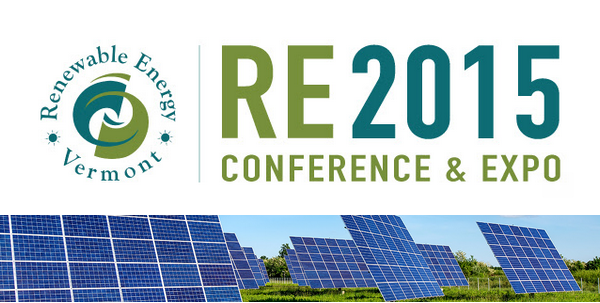 Renewable energy businesses, technology leaders, energy generators, utilities and environmental organizations along with policy makers and communities will convene in Burlington this month to identify tangible strategies for converting the state’s fossil fueled economy to one driven by renewable sources. Renewable Energy 2015 (RE 2015) is Vermont’s premier event exploring the transition to a clean energy economy. The 15th annual business conference, hosted by Renewable Energy Vermont (REV) is slated for October 8 and 9 at the Sheraton Hotel and Conference Center in Burlington, VT.
Renewable energy businesses, technology leaders, energy generators, utilities and environmental organizations along with policy makers and communities will convene in Burlington this month to identify tangible strategies for converting the state’s fossil fueled economy to one driven by renewable sources. Renewable Energy 2015 (RE 2015) is Vermont’s premier event exploring the transition to a clean energy economy. The 15th annual business conference, hosted by Renewable Energy Vermont (REV) is slated for October 8 and 9 at the Sheraton Hotel and Conference Center in Burlington, VT.
With expert speakers on a diverse array of topics, this dynamic forum will look at the opportunities and hurdles involved in moving toward an integrated energy infrastructure addressing power, heating and transportation needs. The conference spans two days and features over 25 conference sessions with more than 65 speakers from throughout the region.
Topics covered include: wind, solar, bioenergy technologies, transportation, resilient grid technology, energy efficiency and energy storage solutions. Conference sessions will look at hurdles to implementing renewables as well as untapped opportunities, technological innovations and tools for financing renewable energy.
To learn more about the 2015 Renewable Energy Conference & Expo’s agenda, exhibitors, and sponsors you can visit the conference website as well as follow the hashtag #RE2015 and Renewable Energy Vermont’s Twitter handle @RE_Vermont for updates!
About Renewable Energy Vermont (REV)
REV is Vermont’s only non-profit, non-partisan renewable energy trade association working to reduce our dependence on fossil fuels and expanding the availability of renewable sources of energy throughout the state and region.
14 Sep 2015
Vermont Farmer Helps Others Produce Biofuel
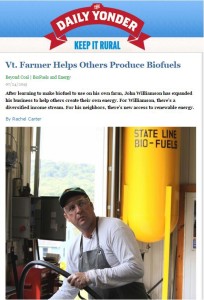 The Vermont Bioenergy Initiative, a program of the Vermont Sustainable Jobs Fund, aims to foster the sustainable bioenergy through a local production for local use model, proven to work for Vermont. Since 2003 the program has allowed Vermont farms to ease their resilience on inconsistently priced, foreign fossil fuels and other agricultural inputs. This is accomplished by focusing on biodiesel production and distribution for heating and transportation, oil crops for on-farm biodiesel and feed, grass energy for heating, and algae production for biofuels and waste management.
The Vermont Bioenergy Initiative, a program of the Vermont Sustainable Jobs Fund, aims to foster the sustainable bioenergy through a local production for local use model, proven to work for Vermont. Since 2003 the program has allowed Vermont farms to ease their resilience on inconsistently priced, foreign fossil fuels and other agricultural inputs. This is accomplished by focusing on biodiesel production and distribution for heating and transportation, oil crops for on-farm biodiesel and feed, grass energy for heating, and algae production for biofuels and waste management.
Vermont Bioenergy Initiative grantees have shown just how much the addition of biomass feedstock can contribute to sustainable agriculture. As one of these grantees, John Williamson of Stateline Farm would put it, “100 years ago everyone produced their own fuel; we are just doing that now in a different way.” This is really a novel way to look of what he is doing on his North Bennington farm. John was featured in a recent story in Daily Yonder which outlined his work and how he has begun helping his Vermont neighbors find their path to this form of sustainable, renewable energy.
For more about John Williamson’s on-farm biodiesel production, watch this video of John in self-designed Biobarn. He and Chris Callahan of University of Vermont Extension show us how they can grow oil crops, make biodiesel, feed animals, and save money!
Also, explore the initiative’s extensive and accessible set of bioenergy resources for replication in rural communities across the United States and beyond.
07 Sep 2015
Weekly Energy Action Seminars at UVM
Beginning Monday the 14th of September, and reoccurring each week thereafter, an Energy Action Seminar Series aims to explore energy transitions in Vermont, the United States and the rest of the World. Sponsored by the University of Vermont’s Clean Energy Fund, Community Development & Applied Economic program, and the Environmental Program this series will be held from 4:00-05:20 pm in Lafayette Hall Room 108* at the University of Vermont. This series featuring world-class speakers on policy options, political controversy, costs and benefits, activism, and jobs is free and open to the public.
While there is already an extensive line-up of speakers, the most high profile speaker to stand out on the list is former Vice President Al Gore. Gore will draw on his years of climate advocacy for his discourse entitled “The Climate Crisis and The Case for Hope.” When delivering this discourse, Gore aims to address three big questions on the climate crisis: Do we need to change? Can we? And will we? The resounding answer to first two questions of course is a loud YES, but third one most likely cannot be answered in certain terms, and hopefully this where Gore can leave us all with “a case for hope.” NOTE: There is a slight deviation of schedule; this seminar will be on Tuesday, October 6th at 10:15 AM in Ira Allen Chapel.
In addition to Al Gore, numerous other leaders from near and afar will attend and speak during the duration of this series. One such visitor on September 21st, Professor Miranda Schreurs of Free University of Berlin and Director of their Environmental Policy Cente,r stands to bring a plethora of insight from her experience in Germany’s renewable energy revolution. In her time with the Environmental Policy Research Center, Professor Schreurs was on the frontlines of the interdisciplinary collaboration of university researchers necessary for Germany to meet it’s ambitious goal of running almost their entire economy on renewable energy by the year 2050. Germany’s goal is very similar to Vermont’s 2050 goal, and the potential for collaboration and to learn from one another through this event are boundless.
Another great guest speaker will come from Washington, all the way across the US,. Yoram Bauman, more commonly known “Stand-Up Economist,” uses a unique combination of witty comedic talent along with his PhD in Environmental Economics to help an audience explore climate change in an economic context. Yoram’s seminar exploring carbon taxing on October 10th will fall just a couple of days after he serves as the keynote speaker and sits on a carbon pricing panel at the 15th Annual Renewable Energy Conference & Expo in Burlignton, VT. His fresh and recent insight into Vermont’s existing carbon pricing discussion mixed with his existing expertise, and sense of humor will make this event worth not missing.
Additionally, many Vermont energy leaders will be speaking at theses weekly seminars including Representative Tony Klein Chair of House Energy and Natural Resources, Asa Hopkins Director of Planning for the Department of Public Service, Gabrielle Stebbins Director of Renewable Energy Vermont, and Mary Powell of Green Mountain Power. Each of these speakers, as well as the entities they represent, have proven themselves leaders in the Vermont energy landscape through their involvement in recent energy legislation, advocacy, and innovation.
| 9/14 | Energy Transitions | Jennie Stephens, Blittersdorf Professor of Sustainability Science & Policy, University of Vermont |
| 9/21 | Going Green: The German Energy Transition | Miranda Schreurs, Professor, Free University of Berlin Director, Environmental Policy Center |
| 9/28 | The Vermont Energy Transition | Tony Klein, Chair: House Energy and Natural Resources, Asa Hopkins, Director of Planning, Department of Public Service. Gabrielle Stebbins, Director, Renewable Energy Vermont |
| 10/5 | Student Alumni: Making a Difference in the World | Panel: Recent UVM grads in energy-related fields |
| 10/6* | The Climate Crisis and The Case for Hope | Al Gore, former Vice-President, United States |
| 10/12 | Carbon Taxes: Why We Need Them | Yoram Bauman, The world’s only “stand-up” Economist |
| 10/19 | Challenging the Car: Creating places where biking is safe & easy | Steve Clark, League of American Bicyclists, Community Organizer |
| 10/26 | Vermont’s Energy Company of the Future: A Customer Driven Energy Transformation | Mary Powell, President & CEO, Green Mountain Power |
| 11/2 | “The War on Coal:” Big Fossils’ Response to Divestment | Jen Schneider, Political Science Dept. Boise State University |
| 11/9 | The Transportation Transition: Complete Streets | Roger Millar, Director, SmartGrowth America |
| 11/16 | Energy Transitions in the Developing world: South Africa Settlements | Steve McCauley, Worcester Polytechnic Institute |
| 11/30 | Design Matters: Building Green | Rolf Keilman, Partner, Truex-Cullins, Vermont |
* Al Gore presentation is in the Ira Allen Chapel, special time, 10:15 a.m. Oct. 6
For more information contact
Fred Hall fhall@uvm.edu
Roison Low rlow@uvm.edu
Richard Watts rwatts@uvm.edu
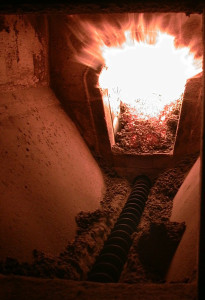 Efficiency Vermont, Renewable Energy Resource Center, Renewable Energy Vermont and Clean Energy Development Fund combine efforts to bring up to $5,500 in rebates to Vermonters who heat local
Efficiency Vermont, Renewable Energy Resource Center, Renewable Energy Vermont and Clean Energy Development Fund combine efforts to bring up to $5,500 in rebates to Vermonters who heat local
Through a generous opportunity, Vermonters now have a short-time frame before the new year to capitalize on a fantastic incentive offering that helps them save money, while supporting Vermont jobs and sustainable forests, while making sure they stay warm this winter.
Vermonters can get up to $5,500 to help switch from fossil fuel to local wood heating. Cash incentives are available from the Clean Energy Development Fund and Efficiency Vermont. Renewable Energy Vermont and the Renewable Energy Resource Center have partnered to help promote the incentives.
“We’ve been very happy with our decision to switch to a wood pellet boiler. Not only do we save money every year on our fuel bill, but we also love the fact that we’re helping to keep forests intact and logging jobs going,” says Mark Bushnell of Middlesex.
Vermonters who make the switch to wood pellet fuel typically save $1,500 annually when compared to oil and propane fuel heating options. And for those who are used to whole-home heating through their traditional boiler, the wood pellet boiler keeps it simple and complete. Advanced wood pellet boilers are fully automatic, so there’s no work for the home or business owner.
“I heated my home for years with a standard wood stove, but I’m happier with my wood pellet boiler. The new boiler is much more efficient and better for the environment because it is cleaner burning. And it feels great to be off fossil fuels,” says Susan Clark of Middlesex.
Wood pellet boilers, though not well known in the United States, are the primary way of heating in some parts of the world, including Upper Austria where more than 40,000 homes and businesses heat with wood from their background in an easy, seamless way. In fact, the State of Vermont and Upper Austria are involved in a Sister Statehood Agreement to help learning across both sides of the Atlantic to increase the uptake of this sustainable, local heating option.
“For many years, Vermont has been a national leader in the use of modern wood heating systems in large buildings like schools, office buildings, and apartment buildings. With pellets now available in bulk using specialized delivery trucks that conveniently blow pellets into a fuel bin and heating systems that are fully-automated, many homeowners and small businesses are also making the switch from oil and propane,” said Adam Sherman of the Biomass Energy Resource Center.
For more information, please go to www.advancedwoodheat.com
Media Contacts:
Renewable Energy Vermont, Ansley Bloomer, ansley@revermont.org (802) 595-0723
Biomass Energy Resource Center, Alayna Howard, ahoward@veic.org (802) 540-7656
Renewable Energy Resource Center, Alayna Howard, ahoward@veic.org (802) 540-7656
Efficiency Vermont, Alayna Howard, ahoward@veic.org (802) 540-7656
Clean Energy Development Fund, Andrew Perchlik, andrew.perchlik@state.vt.us (802) 828-4017
17 Aug 2015
The Third Annual National Bioenergy Day
The T hird Annual National Bioenergy Day (NBD), which will take place Wednesday, October 21st, is a day that is marked with events from across the country that celebrates energy independence, local jobs, and many other benefits of local bioenergy. Led by Biomass Power Association in partnership with U.S. Forest Service, National Bioenergy Day is an opportunity for Vermonters to showcase our research, progress, and impacts in producing local bioenergy for local use.
hird Annual National Bioenergy Day (NBD), which will take place Wednesday, October 21st, is a day that is marked with events from across the country that celebrates energy independence, local jobs, and many other benefits of local bioenergy. Led by Biomass Power Association in partnership with U.S. Forest Service, National Bioenergy Day is an opportunity for Vermonters to showcase our research, progress, and impacts in producing local bioenergy for local use.
How To Get Involved:
- Organize an event on or near October 21ndthat showcases bioenergy as a clean, efficient, and resourceful way to produce energy. Emphasizes bioenergy’s role in improving environmental health; and facilitates collaboration along the supply chain.
- Partner with someone who works in the bioenergy supply chain to create an event. Use the Vermont Energy Atlas to find partners in your area.
- Piggyback on an existing event and call it a NBD event.
- Share and talk about NBD in your social media and press efforts while promoting impacts in your community.
The Vermont Bioenergy Initiative, for example, will spend the day re-capping and previewing events and research on our Twitter handle @VTBioenergy that took place throughout the summer and that are planned for the fall. We’ll be recapping and sharing exciting things like the exciting learning opportunities at the University of Vermont, Full Sun Company’s Biodiesel and Meal production, and much more!
For more information, you can visit also visit bioenergyday.com and follow @USAbiomass on twitter!
Click Here for National Bioenergy Day Participation Guide!
In early 2014 Full Sun Company, a small start-up business was co-founded by Netaka White and Davis McManus. Fueled by an interest to help family farms grow, Full Sun began processing sunflower and non-GMO canola oil crops into specialty food-grade oil and high-protein meal for the farmers. Sunflower and canola oil distribution picked up quickly through local CSAs, farm stores, specialty food shops, health and wellness centers, and direct sales to chefs in the Northeast.
Netaka White previously served as the Vermont Bioenergy Initiative’s (VBI) program director, which directly helped to develop the business model to nurture farm partnerships, both as growers and recipients of oilseed meal – the other product that’s generated from making the oil. At Full Sun oilseeds are pressed with large mechanical machinery, producing oil and a granular meal. The team at Full Sun Company learned a lot about seed storage and oil pressing from the early VBI grantees, such as John Williamson of State Line Farm, and Roger Rainville of Borderview Farm.
The first of the two products, the seed meal, has been used as fuel for pellet stoves, or as is the case with Full Sun, sold as fertilizer for crops, or nutritional meal for livestock. At full operation, Full Sun can pump out one ton of meal per day – necessary to meet the growing demand of such customers as The Intervale in Burlington, Vermont and several local pig, poultry, dairy, and beef producers.
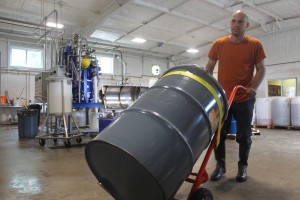
Full Sun Company employee, Zach Hartlyn, moves an off-spec oil barrel for biodiesel production
Credit: Full Sun Company
The second product, the oil, is used as culinary oil for cooking. Staying true to their commitment to an extraordinary culinary product, Full Sun Company diverts any of the oil that does not meet their standards to Vermont Bioenergy Initiative biofuel producers to undergo further processing and become biofuel. Approximately 250-300 gallons of off-spec oil for biodiesel has been processed since February, 2014.
In October, 2014, Full Sun Company halted operation to make room for growth to meet the increased demand for their products and scale up to align with Vermont’s accelerating agricultural economy. White and McManus acquired the former Vermont Soap building in Middlebury, Vermont in order to build a full scale mill and achieve their anticipated greater capacity. Over the course of one of the coldest winters in recent history, the Full Sun team made the renovations and adjustments needed to repurpose the building into the first non-GMO verified oil mill in New England. By March of 2015 Full Sun Company had pressed sunflower and canola seeds to make their first batch of specialty oils. The new operation can yield 130 gallons of oil per day – about 2600 gallons per month!
With no shortage of innovation or ambition, White notes, “David and I are in this with the interest of having a transformative effect on local agriculture and food systems.” Well on their way, the operation is certified GMO free, and the next steps are being taken towards becoming certified organic.
As they grow, Full Sun would like to buy from local grower-suppliers and work with local businesses to package and label feed to be distributed to farmers of varying sizes, from backyard chicken growers to larger operations. Collaborating with Vermont breweries and distilleries is also in queue. Full Sun is working with one local distillery to put together “a package” for farmers so they have markets for profitable grain crops throughout four years of rotation (rye, wheat, sunflowers, etc.) and can offer farmers the indexed prices for these locally grown grains and oilseeds.
27 Jul 2015
Summit on Creating Prosperity and Opportunity Confronting Climate Change – Looking Back and Looking Forward
 The Summit on Creating Prosperity and Opportunity Confronting Climate Change brought together over 400 innovative business, non‐profit, and community leaders, elected officials, public policy advocates, students, and interested residents to begin to frame policy and investment strategies to advance the development of the Vermont Climate Economy. Summit participants developed a list of key practical actions to serve as a launching point for the Vermont Climate Change Economy Council (VCCEC), a group charged with a one year mission to develop a structured plan with practical actions to reduce carbon emissions and stimulate green economic development in Vermont. The Council will build a set of public/private strategies designed to promote economic opportunity, innovative business development, investment, and job creation in Vermont.
The Summit on Creating Prosperity and Opportunity Confronting Climate Change brought together over 400 innovative business, non‐profit, and community leaders, elected officials, public policy advocates, students, and interested residents to begin to frame policy and investment strategies to advance the development of the Vermont Climate Economy. Summit participants developed a list of key practical actions to serve as a launching point for the Vermont Climate Change Economy Council (VCCEC), a group charged with a one year mission to develop a structured plan with practical actions to reduce carbon emissions and stimulate green economic development in Vermont. The Council will build a set of public/private strategies designed to promote economic opportunity, innovative business development, investment, and job creation in Vermont.
Over the course of 2015, VCCEC will evaluate findings, key ideas and suggested action steps derived from the Summit, lead regional public forums, evaluate and summarize research findings, interview key stakeholder groups, and consider model economic development strategies from other state and countries. During 2015, the group will develop a strategic platform of recommendations for action, and report to the Vermont legislature, the Governor of Vermont and the public in January 2016. The Vermont Council on Rural Development (VCRD) will provide support to their work and then help promote the platform of action that comes from its deliberants. Goals of the Vermont Climate Change Economy Council are to:
- Identify opportunities created by climate change to strengthen Vermont’s economy through strategies advancing key business clusters and economic sectors.
- Build an increased sense of unity in Vermont around policies to confront and mitigate the impact of climate change and to advance economic opportunities and solutions that respond to climate change.
- Build a public information campaign to celebrate innovation and Vermont’s green business leadership; internally and externally marketing to build the Vermont brand as an economic/environmental problem solver.
- Expand Vermont’s economic brand around climate change solutions to retain and attract youth and creative entrepreneurs to locate throughout the state.
Vermont businesses and nonprofits are addressing climate change – both its challenges and opportunities. Their creative solutions are a growing part of our state’s economy. What are your experiences? Do you have ideas about how Vermont can grow jobs and nurture innovative business development in sectors ranging from clean energy, to recycling, transportation systems, and thermal efficiency?
Jo![Regional_Forum_Flyer5_15_statewide[1]](http://vermontbioenergy.com/wp-content/uploads/2015/07/Regional_Forum_Flyer5_15_statewide1-150x150.jpg) in the Vermont Council on Rural Development and local business leaders at a forum on “What’s Next for Vermont’s Climate Change Economy?” Forums will take place at 7:00pm at the Paramount in Rutland (Aug 26), the Latchis Hotel in Brattleboro (Oct 6), and City Hall in Burlington (Oct 29). Come to the forum(s) most convenient for you.
in the Vermont Council on Rural Development and local business leaders at a forum on “What’s Next for Vermont’s Climate Change Economy?” Forums will take place at 7:00pm at the Paramount in Rutland (Aug 26), the Latchis Hotel in Brattleboro (Oct 6), and City Hall in Burlington (Oct 29). Come to the forum(s) most convenient for you.
These forums are the next step for public input to the Vermont Climate Change Economy Council, a group working to develop a practical plan to reduce carbon emissions and stimulate economic development in Vermont. To learn more about the forums and the Council visit VCRD’s website at vtrural.org, download the event flyer (pdf).
For more information about the results of the summit, Click HERE to read the report and follow the hashtag #VTClimateEconomy and Vermont Council on Rural Development on Twitter at @VTRuralDev for more updates!




